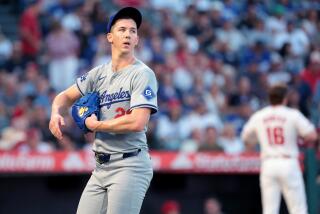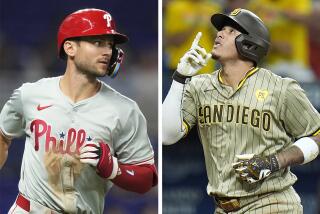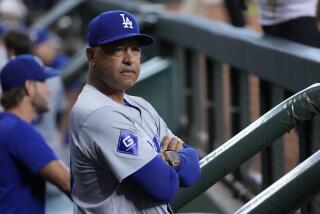Arms Race
On the darkest day of the Dodger season, a day so bleak they lost ground even though every National League team was idle, this much became clear:
If they don’t make the playoffs, they can’t blame Barry Bonds, Randy Johnson or Curt Schilling.
If they don’t make the playoffs, the culprits will be Armando Rios, Ryan Vogelsong and Ruben Quevedo.
These were the expendable prospects used Monday by contending teams to acquire top players.
These are the types of prospects the Dodgers don’t have.
They don’t have them because, during the mid-1990s, they didn’t sign or develop them.
For all its greatness, the Peter O’Malley legacy left the Dodgers with a poison pill now coursing through their veins.
The franchise that popularized the minor leagues no longer has a system to stand on.
We’ve known this for a while. But it’s never affected the Dodgers quite like this.
Start with Monday’s trade of setup man David Weathers from the Milwaukee Brewers to the Chicago Cubs.
The Dodgers wanted Weathers. With a 2.03 earned-run average, he would have served as a human Magic Fingers for those aching middle relievers.
Thousands of fans watching weary Matt Herges struggle against the Rockies on Sunday surely agreed.
So did the Brewers, who preferred to trade Weathers to the Dodgers rather than a team in their own division.
It was the perfect deal, but for one problem.
The Cubs could give the Brewers a top triple-A pitcher named Ruben Quevedo, a guy who could come up and start immediately in the big leagues.
Last we looked, the Dodgers have no triple-A pitchers.
Weathers goes to Chicago, and the Dodger bullpen remains stormy.
“I think it’s no secret, we have to solidify the foundation of our organization,” said Dave Wallace, interim general manager.
Then there was Monday’s trade of pitcher Jason Schmidt and outfielder John Vander Wal from the Pittsburgh Pirates to the San Francisco Giants.
Talk about a nasty hot breath on your neck.
Last week, the Giants acquired veteran first baseman Andres Galarraga from the Texas Rangers. Then they swept a four-game series in Arizona.
Now this, the acquisition of an emerging pitcher and an outfielder who is five for 12 in the National League Championship Series and World Series.
The Giants still trailed the first-place Dodgers by four games Monday. But suddenly, it felt the other way around.
All because the Giants, without hurting themselves, were able to give the Pirates a couple of guys who could fill holes in their outfield and starting rotation.
The Dodgers make that kind of deal, they sink their season.
And to the Rangers, the Giants were able to ship two triple-A players and a double-A player.
Anybody even know where the Dodgers’ double-A franchise is located?
It’s in Jacksonville, Fla., where it moved this year after leaving San Antonio fans who grew tired of rarely seeing a prospect.
“What we have now are players who are two and three years away,” said Wallace. “And because of the nature of the business, if you think you have three prospects, maybe only one will work out. So you need plenty of them. You need to build depth.”
The Dodgers don’t have that depth. Every top kid is dressing in Dodger Stadium.
That their trade for James Baldwin was called “the steal of the year” by one scout illustrates not only the acumen of Wallace and assistant Dave Evans, but their current troubles.
They got Baldwin for nothing because that’s all they had to give.
The deal was so lopsided, the White Sox couldn’t even believe it themselves, issuing a press release announcing they had acquired, as one of three minor leaguers, good pitching prospect Jon Berry of Class-A Vero Beach.
Of course, the Dodgers can’t trade good pitching prospects, and had instead given the Sox a 32-year-old journeyman outfielder named Jeff Barry.
“How could they have confused the two guys?” mused one scout. “The one Berry can play, and the other Barry can’t.”
Scouts say the Sox would have been smarter simply to allow Baldwin to leave as a free agent so they could have received draft picks, anything being better than what the Dodgers gave them.
It would be funny, if it weren’t so sad.
“That’s the message we’re sending now,” said Wallace. “We want to be competitive, but we have to keep the future in mind.”
Wallace knows. As a pitching instructor, he was roving the Dodger minor league fields during the ‘80s and early ‘90s, during which time they developed seven rookie-of-the-year winners.
But considering Todd Hollandsworth did not have award-type numbers and that Hideo Nomo was developed in Japan, the Dodgers haven’t had a true farm system star since Raul Mondesi was a rookie in 1994.
By then, O’Malley had turned the entire system over to Charlie Blaney, a nice man and former Dodgertown executive who was a better administrator than talent evaluator.
In the final years under Blaney, the grass-roots baseball people were increasingly ignored, and the system suffered through territorial feuds and partisanship.
All you need to know about that time period is this:
For eight years, Paul Lo Duca languished in the minors while Ralph Avila, the Latin American boss, pushed Dominican catcher Angel Pena.
All you need to know about the amateur draft is this:
There hasn’t been a Dodger first-round pick to make an impact on a contending Dodger team in 20 years, since Dave Anderson in 1981.
Kevin Malone said he wanted to fix all of this, but his lieutenants sometimes caused even more problems with what minor-league personnel said was arrogance.
Under the low-key Wallace, who likes player development so much he wants to return there after his interim duties are completed, this could all change.
If nothing else, he realizes that it must change.
“In some of these trade cases, we didn’t have the fit that some people wanted,” Wallace said. “Other teams had that fit.”
A good fit in July often means a great fit in October, to where the Dodgers must now trudge, a team whose proud history now shackles them.
More to Read
Are you a true-blue fan?
Get our Dodgers Dugout newsletter for insights, news and much more.
You may occasionally receive promotional content from the Los Angeles Times.











